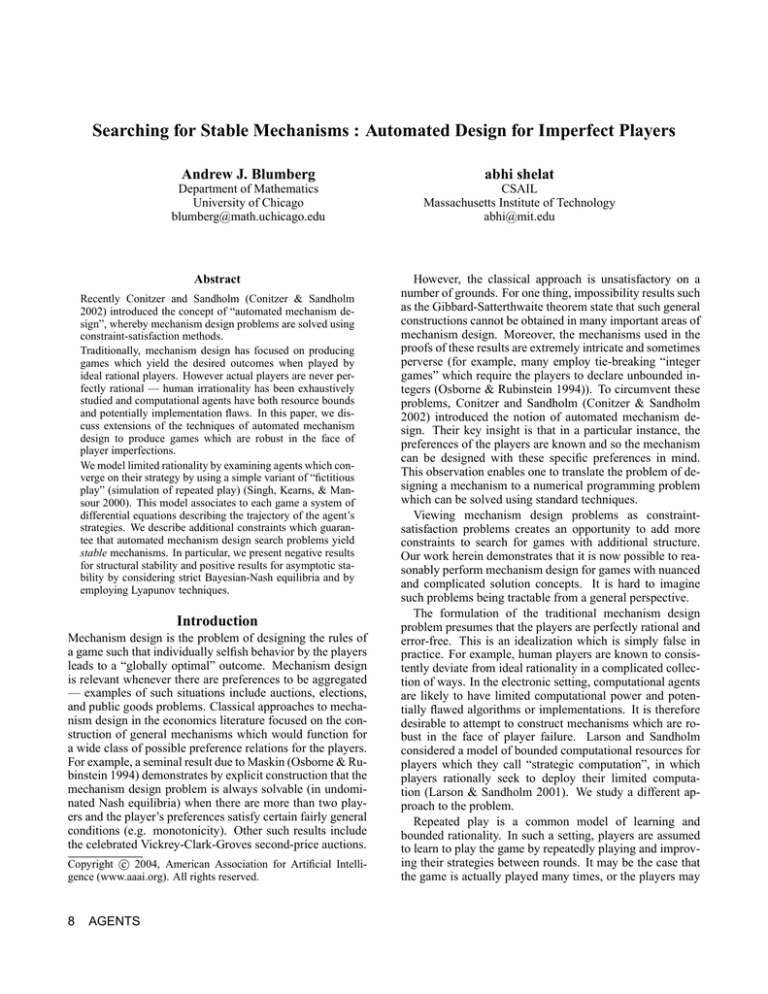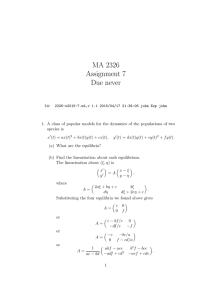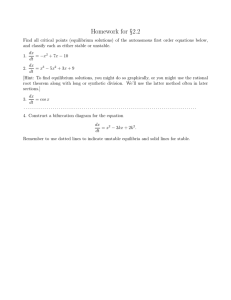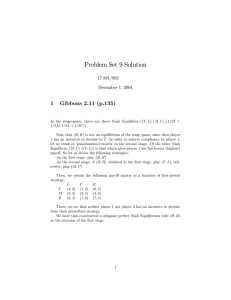
Searching for Stable Mechanisms : Automated Design for Imperfect Players
Andrew J. Blumberg
abhi shelat
Department of Mathematics
University of Chicago
blumberg@math.uchicago.edu
CSAIL
Massachusetts Institute of Technology
abhi@mit.edu
Abstract
Recently Conitzer and Sandholm (Conitzer & Sandholm
2002) introduced the concept of “automated mechanism design”, whereby mechanism design problems are solved using
constraint-satisfaction methods.
Traditionally, mechanism design has focused on producing
games which yield the desired outcomes when played by
ideal rational players. However actual players are never perfectly rational — human irrationality has been exhaustively
studied and computational agents have both resource bounds
and potentially implementation flaws. In this paper, we discuss extensions of the techniques of automated mechanism
design to produce games which are robust in the face of
player imperfections.
We model limited rationality by examining agents which converge on their strategy by using a simple variant of “fictitious
play” (simulation of repeated play) (Singh, Kearns, & Mansour 2000). This model associates to each game a system of
differential equations describing the trajectory of the agent’s
strategies. We describe additional constraints which guarantee that automated mechanism design search problems yield
stable mechanisms. In particular, we present negative results
for structural stability and positive results for asymptotic stability by considering strict Bayesian-Nash equilibria and by
employing Lyapunov techniques.
Introduction
Mechanism design is the problem of designing the rules of
a game such that individually selfish behavior by the players
leads to a “globally optimal” outcome. Mechanism design
is relevant whenever there are preferences to be aggregated
— examples of such situations include auctions, elections,
and public goods problems. Classical approaches to mechanism design in the economics literature focused on the construction of general mechanisms which would function for
a wide class of possible preference relations for the players.
For example, a seminal result due to Maskin (Osborne & Rubinstein 1994) demonstrates by explicit construction that the
mechanism design problem is always solvable (in undominated Nash equilibria) when there are more than two players and the player’s preferences satisfy certain fairly general
conditions (e.g. monotonicity). Other such results include
the celebrated Vickrey-Clark-Groves second-price auctions.
c 2004, American Association for Artificial IntelliCopyright gence (www.aaai.org). All rights reserved.
8
AGENTS
However, the classical approach is unsatisfactory on a
number of grounds. For one thing, impossibility results such
as the Gibbard-Satterthwaite theorem state that such general
constructions cannot be obtained in many important areas of
mechanism design. Moreover, the mechanisms used in the
proofs of these results are extremely intricate and sometimes
perverse (for example, many employ tie-breaking “integer
games” which require the players to declare unbounded integers (Osborne & Rubinstein 1994)). To circumvent these
problems, Conitzer and Sandholm (Conitzer & Sandholm
2002) introduced the notion of automated mechanism design. Their key insight is that in a particular instance, the
preferences of the players are known and so the mechanism
can be designed with these specific preferences in mind.
This observation enables one to translate the problem of designing a mechanism to a numerical programming problem
which can be solved using standard techniques.
Viewing mechanism design problems as constraintsatisfaction problems creates an opportunity to add more
constraints to search for games with additional structure.
Our work herein demonstrates that it is now possible to reasonably perform mechanism design for games with nuanced
and complicated solution concepts. It is hard to imagine
such problems being tractable from a general perspective.
The formulation of the traditional mechanism design
problem presumes that the players are perfectly rational and
error-free. This is an idealization which is simply false in
practice. For example, human players are known to consistently deviate from ideal rationality in a complicated collection of ways. In the electronic setting, computational agents
are likely to have limited computational power and potentially flawed algorithms or implementations. It is therefore
desirable to attempt to construct mechanisms which are robust in the face of player failure. Larson and Sandholm
considered a model of bounded computational resources for
players which they call “strategic computation”, in which
players rationally seek to deploy their limited computation (Larson & Sandholm 2001). We study a different approach to the problem.
Repeated play is a common model of learning and
bounded rationality. In such a setting, players are assumed
to learn to play the game by repeatedly playing and improving their strategies between rounds. It may be the case that
the game is actually played many times, or the players may
be individually simulating the repetition of the game in order to converge on a strategy to play in a one-shot game (this
is called “fictitious play”). Such learning processes can be
modeled by a system of differential equations describing the
updates of the strategy profiles of the players. We study the
stability of a potential mechanism by examining the stability
of this associated system of differential equations. A robust
mechanism is one for which the associated system is stable
and robust in the face of noise both in the description of the
game and in the specification of the strategies.
In the following sections, we explore several notions of
stability. We examine structural stability (the robustness of
qualitative behavior of the trajectories in the face of perturbation of the system of equations) and prove that for some
classes of games, automated mechanism design will never
yield structurally stable solutions. In general, we discuss
how to determine if the associated system is structurally stable. Then we consider asymptotic stability of equilibrium
points (the robustness of an equilibrium in the face of small
perturbations of the state of a system). We describe how
to write constraints which guarantee that solutions to the
automated mechanism design search problem have asymptotically stable equilibria by searching for Lyapunov functions (Merkin 1997).
Background
A central solution concept in games of incomplete information is the Bayesian-Nash equilibrium, which we review
here (see (Fudenberg & Tirole 1991) for a detailed presentation). In a Bayesian-Nash setting, each of the n players in a
game know their own type θi (private information), but only
have a probability distribution over the types of the other
players. Each player also has a set of actions, Ai . An outcome, or action profile, is the tuple of actions chosen by all
the players and is a member of A = A1 × A2 × · · · × An .
Each player also has a utility function which maps their type
and an outcome of the game to a particular payoff.
(Informal) Bayesian-Nash Equilibrium A set of strategies is a Bayesian-Nash equilibrium if for each player, and
for each possible type of that player, the expected utility of
the player’s strategy (given the distribution of other players’
types and that their strategies are fixed) is greater than or
equal to the expected utility of any other strategy for that
player.
Automated mechanism design
Now we review the formal setting for automated mechanism
design problems.
Definition In an automated mechanism design setting, we
are given :
1. A finite set of players N .
2. A finite set of outcomes O.
3. For each player i, a set of types θi , and a probability distribution over θi .
4. For each player i, a utility function ui : θi × O → R
which maps types and outcomes to utilities.
5. A social objective function whose expectation the designer is to maximize.
6. A solution concept (e.g. Bayesian-Nash equilibrium).
7. Additional constraints — for example, whether the mechanism can employ randomness or side-payments.
The goal of a mechanism design problem is to produce
a game G which is a map G : S1 × S2 × . . . × Sn →
χ(O), where χ(O) is the space of probability distribution
over O and each Si is a set of actions for player i to play.
When randomized outcomes are not allowed, χ is restricted
to distributions with all of their weight on a single outcome.
Note that the set of pure strategies for each player in this
game are the same as the set of types– in other words, in the
game, each player is to announce a type, and the collective
actions of all players determines the outcome.
The mechanism G is a truth-telling mechanism if the set
of strategies in which all players announce their types honestly forms an equilibrium with respect to the solution concept.
We assume in the remainder of the paper that the solution concept is Bayesian-Nash equilibrium, randomized
outcomes are permitted, and the utility function is the sum
of expected utilities for all players. Conitzer and Sandholm (Conitzer & Sandholm 2002) present a procedure for
expressing mechanism design problems of this type as linear
programming problems.
LP For Mechanism Design Let S = S1 × S2 × · · · × Sn
represent the action profiles, which in this case coincides
with the set of types, Θ = θ1 × · · · × θn . The variables,
{xs,o }, are indexed on S × O and represent the probability
that a particular outcome o occurs given a specified action
profile s = (s1 , . . . , sn ). The objective function of the program is the social welfare function (the sum of the players’
expected utilities). The constraints of the program are:
1. For each action profile s ∈ S, the probabilities associated
with that action profile must sum to 1.
X
∀s∈S
xs,o = 1
o∈O
2. For each player i, the expected utility for the truth-telling
strategy must be greater than or equal to 0. This specifies
that there is nonnegative benefit to the players for participating.
X
∀s∈S
xs,o ui (si , o) ≥ 0
o∈O
Note that in the truth-telling strategy, player i’s utility at a
particular outcome is simply ui (si , o) since si is her true
type.
3. For a given player, the expected utility for the truth-telling
strategy (when all other players are playing the truthtelling strategy) must be greater than or equal to the expected utility for any other pure strategy. This guarantees
that truth-telling is a Bayesian-Nash equilibrium.
X
X
∀s∈S ∀σ∈Si
xs,o ui (si , o) ≥
xs0 ,o ui (σ, o)
o∈O
o∈O
AGENTS 9
(where s0j = sj for j 6= i and s0i = σ)
Remark If we forbid randomized outcomes, this program
becomes a mixed-integer programming problem with linear constraints. Mixed integer programs are still solvable
(although not as efficiently), but in some subsequent constructions we will generate polynomial constraints. Mixedinteger programs with polynomial constraints are undecidable, and so we focus on randomized outcomes which lead
to general nonlinear programming problems.
The strategy profile for player i is represented as a collection of variables {αi,j } indexed on all but one of the possible actions in Si , where αi,j is the probability of playing
action
P j. The probability of the deleted action is implicitly
1− j αi,j in order to ensure that the probabilities sum to 1.
In our case, the set of pure strategies for player i corresponds
to the set of types Si = θi = {θi1 , . . . , θik }, and so αi,j is
the probability that player i announces type θij . Define the
gradient vector for player i as α̂i = (α̇i,1 , . . . , α̇i,k ) where
An example
α̇i,j =
We employ the following divorce settlement example, also
discussed in (Conitzer & Sandholm 2003), to illustrate our
techniques and methodology.
Divorce Settlement. A husband and a wife are getting divorced. An arbitrator must allocate a prized painting.
1. The husband and the wife are each either of type low (L)
or high (H) with respect to their interest in the painting.
2. The possible outcomes are to give the painting to the husband (h), to give it to the wife (w), joint ownership (j), or
to burn the painting (b).
3. The utilities, which are the same for each player, are as
follows: uL (b) = −10, uL (other has) = 0, uL (own) =
2, u( j) = 1, uH (b) = −10, uH (other has) = 0,
uH (own) = 100, uH (j) = 50.
4. Each person is type L with probability 0.8 and type H
with probability 0.2.
In our linear program formulation , the variable xayz represent the probability that the outcome is a given that husband and wife announce types y and z respectively. Solving
the this linear program as described in yields the following
mechanism:
♀/♂
L
L
h=w=j=
H
w=1
H
1
3
h=1
h=w=j=
2
11
,b =
5
11
Figure 1: Divorce Settlement Mechanism. The Husband’s
actions are across the columns, and the Wife’s actions are
302
on the rows. The expected utility for both players is 17 550
.
Note that these numbers are different then the solution
presented in (Conitzer & Sandholm 2003) — there are many
optimal solutions. Interestingly, the solution in (Conitzer
& Sandholm 2003) does not have symmetric utilities: the
8
husband’s utility is 18 11
and the wife’s utility is 16 102
275 .
The dynamical system induced by repeated play
We consider the simple repeated-play gradient-ascent dynamics discussed in (Singh, Kearns, & Mansour 2000). In
this model, each player updates their strategy between simulations of the games by adjusting the probabilities of action
selection along the gradient of their expected utility. A brief
description of the framework follows.
10
AGENTS
∂E[ui ]
∂αi,j
The gradient-ascent method begins at some initial strategy profile s ∈ S and repeatedly updates the strategies by
taking a small step along α̂. To extend the dynamics to
the Bayesian-Nash case, we compute the expected utility assuming that both a player’s own type and the types of the
other players are drawn from given distributions — we assume the player does not use knowledge about their own
type as they simulate. This is reasonable in some circumstances (a player simulating their auction behavior might
well assume that their valuation of an item will fluctuate)
and unreasonable in others. See also (Dekel, Fudenberg, &
Levine 2001) for a discussion of related concerns.
In the same manner as (Singh, Kearns, & Mansour 2000),
we consider the modified dynamics in which steps which go
outside the boundaries of the unit cube are projected back
into the cube. This has the effect that equilibrium points
of the modified dynamics may not be equilibrium points of
the unconstrained dynamics. As such, we have to use modified versions of the analytic tools for stability determination.
See (Blumberg & shelat 2004) for an analysis of this situation.
In addition, it should be noted that the system of differential equations we describe is obtained as the limit for very
small step size of a discrete update process. However, it can
be shown that as the step size decreases the dynamics approach the “continuous dynamics” — we defer further discussion of this to the full paper.
In order to illustrate the gradient-descent repeated-play
dynamics for our running example, we first compute the expected utility for the husband, which we denote V . Here α1
is the probability that the husband plays low when his type is
low, α2 is the probability he plays low when his type is high,
and the same applies to α3 and α4 for the wife. Also, uxyz
is the husband’s expected payoff when the his
Ptype is x and
the actions y and z are played (that is, it is a xayz uy (a)).
For notational convenience, let x represent (1 − x).
V =
L
L
L
(t1 t2 )(α1 α3 uL
LL + α1 α3 uLH + α1 α3 uHL + α1 α3 uHH )+
H
H
H
(t1 t2 )(α2 α3 uH
LL + α2 α3 uLH + α2 α3 uHL + α2 α3 uHH )+
L
L
L
(t1 t2 )(α1 α4 uL
LL + α1 α4 uLH + α1 α4 uHL + α1 α4 uHH )+
H
H
H
(t1 t2 )(α2 α4 uH
LL + α2 α4 uLH + α2 α4 uHL + α2 α4 uHH )
where t1 = t2 = 0.8. The gradient is obtained by differentiating this expression :
∂V
L
L
L
= t1 t2 (α3 uL
LL + α3 uLH − α3 uHL − α3 uHH )+
∂α1
L
L
L
t1 t2 (α4 uL
LL + α4 uLH − α4 uHL − α4 uHH )
(the other derivatives are similar and omitted).
Searching for stability
There are many ways in which the dynamical system defined
above might be unstable. For example, the system might
never converge to any Nash equilibrium, no matter what the
initial conditions are. Or the system might have many Nash
equilibria in addition to the desired one, and each might have
large basins of convergence.
Remark One difficulty with automated mechanism design
is the inability to prevent the existence of extraneous equilibria in addition to the desired solution. This is in contrast
to the mechanisms obtained from the classical general theorems, which do not have any additional equilibria (with respect to the solution concept) — although it should be noted
that much of the unpleasantness of the results obtained there
(e.g. “integer games”) arises from the need to rule out unwanted equilibria. Since “generic” games have large numbers of Nash equilibria (McLennan 1999), this is an issue
worthy of future work.
We are particularly concerned with two types of stability
under perturbation, structural stability and asymptotic stability.
Structural stability
A system of differential equations is structurally stable if
given a specific trajectory, small changes in the coefficients
of the system produce a system with a “nearby” trajectory to
the original (see (Hirsch & Smale 1974) for details). Equilibrium points near which the system is structurally stable
are called hyperbolic. A necessary condition for structural
stability is that all equilibrium points are hyperbolic. This
can be checked by inspecting the Jacobian matrix of the
system of differential equations — if there are no eigenvalues with zero real parts, then the point is structurally stable (Hirsch & Smale 1974).
Unfortunately, our running example never has structurally
stable equilibria. In fact, we have the following general result.
Lemma 1 The Bayesian-Nash gradient dynamics for games
with two players and two types is never structurally stable.
In particular, the divorce settlement mechanism is always
structurally unstable.
Proof Sketch Consider the Jacobian for the dynamics:
∂ α˙1
∂ α˙1
0
0
∂α3
∂α4
0
∂ α˙2
∂ α˙2
0
∂ α˙3 ∂ α˙3 ∂α3 ∂α3
0
0
∂α1 ∂α2
∂ α˙4
∂ α˙4
0
0
∂α1
∂α2
Computing, we find that the the 2 × 2 submatrix in the top
right corner is
∂ α˙1
L
L
L
= t1 t2 (uL
LL − uLH − uHL + uHH )
∂α3
∂ α˙1
L
L
L
= t1 t2 (uL
LL − uLH − uHL + uHH )
∂α4
∂ α˙2
H
H
H
= t1 t2 (uH
LL − uLH − uHL + uHH )
∂α3
∂ α˙2
H
H
H
= t1 t2 (uH
LL − uLH − uHL + uHH )
∂α4
Hence, the two top rows are linearly dependent and so this
submatrix is singular. Similarly, we obtain that the bottom
two rows are linearly dependent, which implies that there
are two nonzero eigenvectors with eigenvalue 0 (one of the
T
T
form (0 0 x y) and the other of the form (z w 0 0) , where
(x, y) is a nonzero solution to the singular 2 × 2 system in
the upper righthand corner and (z, w) is a nonzero solution
to the singular 2 × 2 system in the lower lefthand corner).
2
This result is not surprising as a little bit of experimentation makes it clear that the dynamics are sensitive to small
changes in the payoff matrix. Larger games are not necessarily structurally unstable, and in a forthcoming paper we
determine more precisely the conditions for the BayesianNash gradient dynamics to be structurally stable in general.
Unfortunately, searching for structural stability is hard —
writing constraints that prevent the Jacobian from having
eigenvalues with nonzero real part seems to be infeasible.
Moreover, as some of the equilibrium points of the projected
dynamics are not necessarily equilibrium points of the unconstrained dynamics, this method is not sufficient to analyze behavior on the boundary of the unit cube.
Asymptotic stability
Asymptotic stability means that for small perturbations away
from the equilibrium, over time the system converges back
to that equilibrium point. In contrast to our negative result for structural stability, we are able to generate games
for which the desired Bayesian-Nash equilibrium is asymptotically stable. We take two approaches to searching for
asymptotically stable systems — a “direct” approach and an
approach via an adaptation of Lyapunov’s criterion (Merkin
1997).
Strict Bayesian-Nash equilibria
One of the fundamental insights from evolutionary game
theory is that a major source of instability within various
kinds of response dynamics is the presence of alternative
optimal choices — if there are multiple actions available to
a player which achieve a Bayesian-Nash equilibrium value
(assuming all the other players are fixed and playing their
Bayesian-Nash equilibrium strategies), best-response dynamics can slip between these actions (Samuelson 1997).
Although the concept of an evolutionary Bayesian-Nash
equilibrium does not seem to be easily expressed via constraints (as the definition involves an existential quantification), we can consider instead the (stronger) notion of
AGENTS 11
Bayesian-Nash equilibrium. As the name suggests, strict
Bayesian-Nash equilibrium is defined identically to ordinary Bayesian-Nash equilibria except that the inequalities
are made strict. In other words, there is a unique best response to the equilibrium action profile. When the number of actions is finite, strict Bayesian-Nash equilibria are
asymptotically stable.
In our running example, truth-telling is a Bayesian-Nash
equilibrium. However, any strategy of the form (x, 0) (the
husband is type L and lies about his type with probability
(1−x)) is also a best-response to the truth-telling strategy for
the wife. Therefore, the truth-telling strategy is not asymptotically stable — small perturbations lead to another bestresponse, at which point the gradient will not change the
solution. For example, at the point (0.99, 0, 1, 0) the gradient is (0, −8.9, 0.03, −8.9) which implies that neither party
can improve their situation since their gradients force them
into the boundaries. Thus, even very small deviations from
the truth-telling equilibrium (1, 0, 1, 0) do not return. Fortunately, it is straightforward to modify the linear program
described before in order to search for strict Bayesian-Nash
equilibria.
To produce the strict linear program, we replace the third
set of constraints with
∀s∈S ∀s0i ∈Si
X
xs,o ui (si , o) ≥
o∈O
X
xs,o ui (s0i , o) + o∈O
where controls the precision needed to see the strictness.
Setting = 0.1, and solving the new linear program, we
obtain the following solution:
♀/♂
L
L
w=h=j=
H
w=1
H
1
3
h=1
h=w=j=
43
264
,b =
A problem with this method is that there exist games with
asymptotically stable equilibria which are not strict equilibria, i.e. the condition is too strong. Moreover, picking is a
tradeoff which requires consideration.
The method of Lyapunov functions
The definitive method for proving the asymptotic stability of a solution trajectory is to provide a Lyapunov function (Merkin 1997) for the dynamics.
Lyapunov Function. A Lyapunov function for a system of
differential equations in variables x1 , . . . , xn is a function
Y (x1 , x2 , . . . , xn ) which is positive definite and such that
dY
dt is negative (semi)-definite.
The existence of such a function implies stability at the
origin, and if the derivative is negative definite, the origin
AGENTS
Recursive Lyapunov Function. A recursive Lyapunov
function for a system of differential equations constrained
to lie on the unit cube in variables x1 , . . . , xn is a function
Y (x1 , x2 , . . . , xn ) which is positive definite on the unit
cube and such that dY
dt is negative definite on the unit cube.
In addition, the restriction of dY
dt obtained by setting a
subset of the variables {xj } and the derivatives {x˙j } to 0 is
also negative definite.
We show elsewhere (Blumberg & shelat 2004) the following result, which we employ herein.
Theorem 2 For a given constrained dynamics on the unit
cube, if there exists a recursive constrained Lyapunov function, L, then the dynamics have an asymptotic equilibrium
point at 0.
In the remaining portion of this section, we will use our
theorem in our running example. For the divorce mechanism, we consider a candidate Lyapunov function written as
X
Y =
aij αi αj
i>j
135
264
Figure 2: Strict BNE mechanism. The payoff for each player
at the equilibrium is slightly lower than it was before (17 227
550
vs 17 302
),
but
now
truth-telling
is
a
strict
Bayesian-Nash
550
equilibrium.
12
is asymptotically stable. To utilize this method, we produce
additional constraints for the linear program which induce
a simultaneous search for a mechanism and for a Lyapunov
function which guarantees that the desired equilibrium point
is stable or asymptotically stable (usually the latter). In general, the resulting program will have nonlinear polynomial
constraints. In addition, it is a straightforward matter to
transform coordinates so that the desired equilibrium point
is at the origin.
However, because we are working with a system which is
externally constrained to lie in the unit cube, we must employ a slight modification of the Lyapunov method. This
technique is further developed in (Blumberg & shelat 2004).
Evaluating the derivative, we find that
dY
= 2a11 α1 α̇1 + a12 (α̇1 α2 + x1 α̇2 )
dt
+ a13 (α̇1 α3 + α1 α̇3 ) + . . . + a44 α4 α̇4
We now augment our original program with the extra variables, a11 , . . . , a44 and now determine additional constraints
in order to guarantee that Y is positive definite. To assure
definiteness, we could employ the following constraints:
1. For every i, aii > 0. This ensures that when all the other
variables are set to 0 the form is still positive.
2. For every i and j, aij ≥ 0.
In order to ensure that dY /dt is negative definite over
the unit cube, we must place additional constraints on the
variables xayz and aij . For the divorce example, calculation
shows that dY /dt is a multivariate polynomial of degree 2.
Consider a generic multivariate polynomial of degree 2,
X
X
ck xk +
dij xi xj
k
i,j
For this to be negative definite on the unit cube, it suffices
for the following conditions to hold:
1. For every i, ci ≤ 0 and ci + dii < 0. This ensures that
when all the other variables are set to 0 the form is still
negative.
2. For every i and j, dij ≤ 0.
Now, in the running example the {ci } and {dij } are algebraic expressions involving the aij , the constants t1 , t2 and
u∗∗∗ , and the other decision variables in the numerical program — {xs,o }. Expanding this out, we obtain a program
with quadratic constraints. For example, the constraint on
c1 requires the following expression be negative:
−8/5a13 xHH,h +8a13 xHH,b −4/5a13 xHH,j −8a13 xHL,b
+ 8a11 xHH,b + 20a12 xLH,h − 20a12 xHH,h + 2a14 xHH,b
− 20a14 xHH,h + 8/5a13 x5 + 4/5a13 xHL,j + 8/5a11 xLH,h
+ 10a14 xHL,j − 2a12 x12 − 4/5a11 xHH,j − 8a11 xLH,b
+ 10a12 xLH,j + 2a12 xHH,b + 4/5a11 xLH,j − 10a14 xHH,j
−2a14 xHL,b −8/5a11 xHH,h −10a12 xHH,j +20a14 xHL,h
Finally, we require the constraints which guarantee that
Y is a recursive Lyapunov function — for every subset of
the variables {xi }, we must have that Y remains a negative definite form when all of the members of the subset and
their derivatives are set to 0. These constraints are generated
using the same criterion for negative definiteness specified
above.
Remark One might be concerned by the quantity of additional constraints required for performing the simultaneous
search for a game and a Lyapunov function. Indeed, the
number of constraints required in the simultaneous search is
exponential in the number of players and actions. Although
this is unpleasant, it is no worse than the general mechanism
design problem, which also requires constraints exponential
in the number of players and actions.
When we solve this program, the game generated has a
strict Bayesian-Nash equilibrium — but in addition we are
provided with a proof of asymptotic stability in the form of
the Lyapunov function encoded in the additional program
variables.
Remark The conditions to ensure definiteness which we
employ are sufficient, but considerably stronger than necessary — we use them for simplicity, but there are benefits
in generality to be obtained by utilizing more precise conditions. Also, larger games will involve higher degree polynomials for which somewhat different conditions are required.
Conclusions
In this paper we have demonstrated extensions of the techniques of automated mechanism design which permit us to
search for (and obtain) mechanisms which possess complicated additional properties beyond those implied by the basic problem statement. We believe that this general method
of exploiting the flexibility of automated mechanism design
to find mechanisms satisfying additional constraints will
have broad applicability. For example, one could construct
mechanisms which are insensitive to certain kinds of collusion.
We apply this methodology to the problem of finding
mechanisms which are robust against player errors by presenting an algorithm which simultaneously searches for a
game and a proof that the desired equilibrium point is
asymptotically stable. We also discuss the difficulties of
finding structurally stable mechanisms. Although we focus
on the dynamics associated to a particular simple model of
learning, any model of bounded rationality which leads to a
dynamical system associated to repeated play is amenable
to a similar analysis. In future work, we plan to extend
our analysis to the system of stochastic differential equations that is associated to the classical economic notion of
fictitious play.
References
Blumberg, A. J., and shelat, a. 2004. Lyapunov methods
for constrained dynamics. Submitted.
Conitzer, V., and Sandholm, T. 2002. Complexity of mechanism design. In Proceedings of the 18th Annual Conference on Uncertainty in Artificial Intelligence (UAI-02),
103–110.
Conitzer, V., and Sandholm, T. 2003. Applications of automated mechanism design. In Proceedings of the UAI-03
Bayesian Modeling Applications Workshop.
Dekel, E.; Fudenberg, D.; and Levine, D. K. 2001. Learning to play bayesian games. In Discussion Papers, number
1322 in 1. Northwestern University, Center for Mathematical Studies in Economics and Management Science.
Fudenberg, D., and Tirole, J. 1991. Game Theory. The
MIT Press.
Hirsch, M. W., and Smale, S. 1974. Differential Equations,
Dynamical Systems, and Linear Algebra. San Diego, CA:
Academic Press.
Larson, K., and Sandholm, T. 2001. Bargaining with limited computation: Deliberation equilibrium. Artificial Intelligence 132(2):183–217.
McLennan, A. 1999. On the expected number of nash
equilibria of a normal form game. University of Minnesota
working paper.
Merkin, D. R. 1997. Introduction to the Theory of Stability.
Springer-Verlag.
Osborne, M. J., and Rubinstein, A. 1994. A Course in
Game Theory. The MIT Press.
Samuelson, L. 1997. Evolutionary Games and Equilibrium
Selection. The MIT Press.
Singh, S.; Kearns, M.; and Mansour, Y. 2000. Nash convergence of gradient dynamics in general-sum games. In
Proceedings of the Sixteenth Conference on Uncertainty in
Artificial Intelligence, 541–548. Morgan Kaufmann.
AGENTS 13








